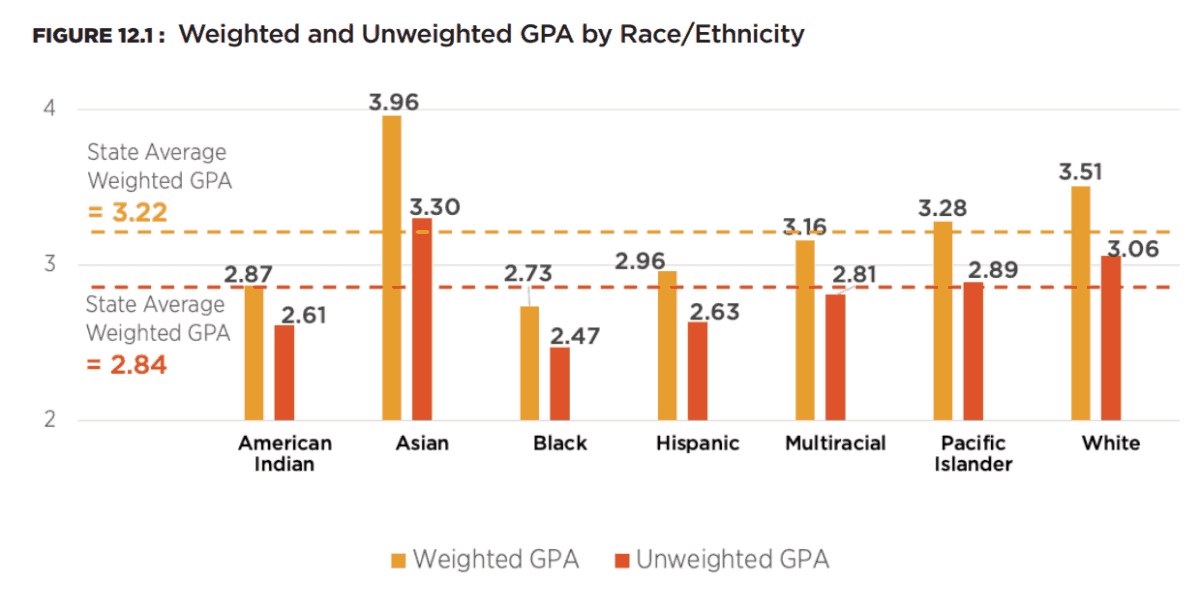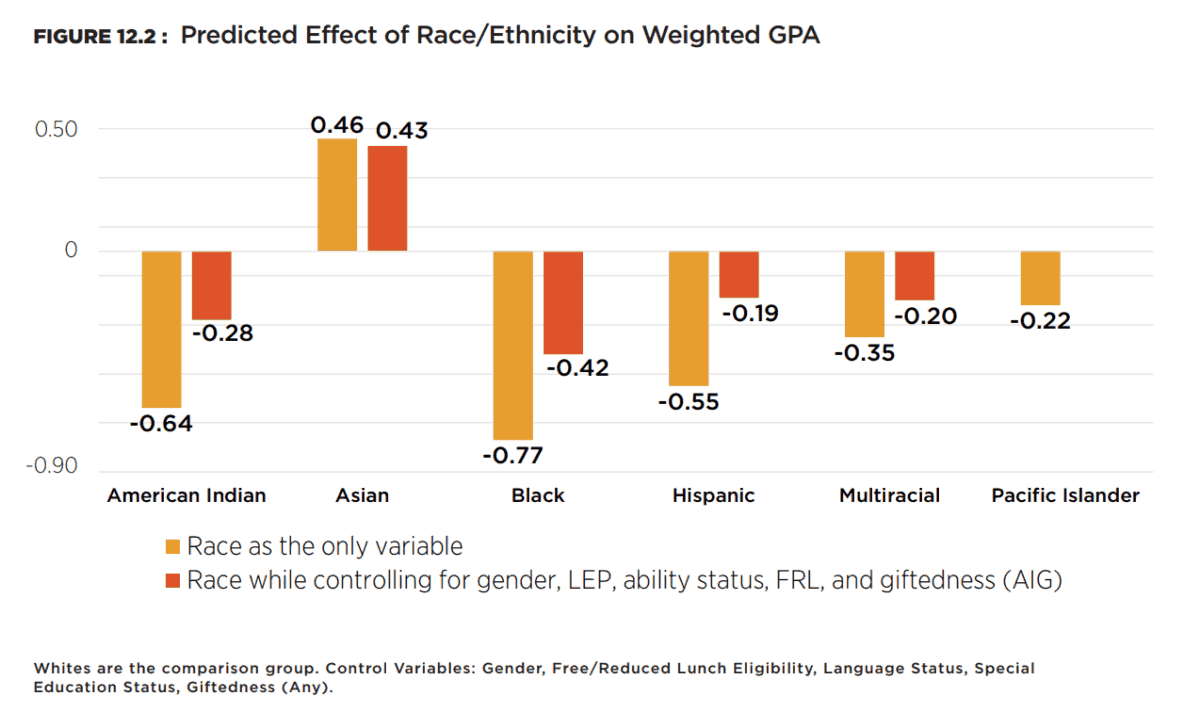This is an excerpt from “E(race)ing Inequities: The State of Racial Equity in North Carolina Public Schools” by the Center for Racial Equity in Education (CREED). Go here to read the full report and to find all content related to the report, including the companion report Deep Rooted.![]()
Grade point average (GPA) represents a student’s average performance in courses over time. GPA is commonly calculated by using a numeric scale, where A = 4.0, B = 3.0, C = 2.0, D = 1.0, and F = 0. GPAs may be calculated at the end of a course, semester, or grade level; however, cumulative high school GPA, an average of all final grades individual students earned during high school, is often what is being referenced in discussions about student academic performance, class rank, and college admissions (Sadler & Tai, 2007).
Most schools use weighted and unweighted GPA calculations as a means of capturing the rigor of students’ coursework. Weighted GPA calculations give students additional points for grades earned in higher-level courses, such as honors courses or Advanced Placement courses. In weighted-grade systems, an A in a higher-level course might be awarded a 4.5 or 5.0, for example, while an A in a lower-level course is awarded a 4.0. Weighting systems often vary widely across schools, districts, and states.
GPA is often used to determine academic honors such as honor roll and class rank. Such honors, along with weighted and unweighted GPA calculations, have historically been an important factor used by colleges, postsecondary programs, and employers to assess a student’s academic ability and performance. Indeed, according to the National Association for College Admission Counseling (Clinedinst & Patel, 2019), more postsecondary institutions assign “considerable importance” to a student’s grades in all courses (i.e. cumulative GPA) than to any other factor in college admissions.
Colleges and universities consider GPA important for good reason. Decades of research has found that GPA is the strongest predictor of a student’s course performance in postsecondary coursework (college GPA) — better than ACT, SAT, or the California Achievement Test (Chissom & Lanier, 1975; Halpin, Halpin, & Schaer, 1981; Noble & Sawyer, 2002). While high school grades appear to be a consistently strong predictor of postsecondary performance in aggregate, research has found that GPA has less predictive utility for some student groups of color, particularly Black and Hispanic students (Zwick & Himelfarb, 2011). The scholars note that this difference may be partially explained by the extent to which these students attend schools with fewer socioeconomic resources.
In North Carolina, statutory law [GS 116-11(10a)] and the North Carolina Department of Public Instruction (NCDPI) govern GPA calculations. NCDPI is legally required to maintain a standardized, automated transcript system that includes GPA and class rank, among other things (NCDPI Policy: High School Transcript Standards, GRAD-009). Schools and LEAs calculate both unweighted and weighted GPAs that reflect additional quality points for advanced coursework.
As of the freshman class of 2015-2016, students receive five quality points for an A in an AP course and four and a half quality points for an A in an honors course. An A in a regular course garners just four quality points.1 The method for GPA calculations is devised by the University of North Carolina System and North Carolina Community College System. As is the case elsewhere, in North Carolina GPA is the basis for class rank calculations. GPA is also a key lever in students’ ability to attain various high school diploma endorsements. Such endorsements identify students who have completed a specialized area of advanced or focused study [NC State Board of Education Policy GRAD-007, High Diploma Endorsements; NC GS 115C-81(b)]. GPA requirements range between 2.5 and 3.5 depending on the type of endorsement.
Methodology
In this report, we position GPA as both an outcome and an access variable. To the extent that GPA shows student performance across their academic work in secondary school, it represents an outcome in achievement. To the extent that different racial/ethnic groups have an equitable ability to attain the benefits of a higher GPA both in high school and postsecondary admissions, GPA represents a measurement of access and opportunity.
In the sections that follow, we analyze average weighted and unweighted GPA as a factor of student race/ethnicity in a sample of approximately 95,000 students. We also look at the spread between weighted and unweighted GPA within and across racial/ethnic groups. We present the results of a model that predicts the weighted GPA based on race/ethnicity, while controlling for gender, free/reduced lunch status, language status, special education status, and giftedness.
Analysis
Figure 12.1 shows the average weighted and unweighted GPA by racial/ethnic group.

White and Asian students have the highest mean weighted GPAs, which are substantially above the state average. Pacific Islander and Multiracial students have mean weighted GPAs close to the state average. Hispanic, American Indian, and Black students have mean weighted GPAs well below the state average. Unweighted GPA follows the same pattern. With the exception of Asian and Pacific Islander students, the mean weighted GPAs of student groups of color fall below the statewide average.
We also built statistical models that predict weighted GPA based on race/ethnicity. Weighted GPA was modeled because it is the core statistic in class rank calculations, it is widely used as a way to differentiate the performance of students for college admissions, and it presumably reflects students’ differences in performance and access to advanced coursework during high school. Model 1 represents predicted difference in weighted GPA between each racial/ethnic groups as compared to White students based on race/ethnicity alone. Model 2 shows the predicted difference based on race/ethnicity while controlling for gender, free/reduced lunch status, language status, special education status, and giftedness.

Race/ethnicity remained a significant and substantial predictor after accounting for other factors in the model. In Model 1, all student groups of color were significantly different than White students. Asian students were predicted to have GPAs approximately 0.46 points higher as compared to White students, and other student groups of color were predicted to have GPAs lower than their White counterparts by approximately 0.25 to 0.75 GPA points. It is worth noting that the negative coefficient for Black students was larger than those of all other student groups of color.
After adding control variables in Model 2, the direction of predicted differences remained the same, except for Pacific Islanders, who were no longer significantly different from Whites. For all student groups of color, the size of the difference between student groups of color and their White counterparts got smaller. However, Asian students were still predicted to have a GPA 0.4 points higher than Whites, while Black students were predicted to have GPAs 0.4 points lower.
Takeaways
Race/ethnicity was a significant and substantial predictor of both weighted and unweighted GPA even after controlling for other related variables. Given its importance as an indicator of academic performance in high school and as a factor in postsecondary admissions, our results raise questions about college readiness across racial/ethnic groups in North Carolina public schools. In addition to simple differences in weighted and unweighted GPA, with the exception of Asian students, all student groups of color have a smaller differential between average weighted and unweighted GPAs, and the same groups also fall below the statewide differential. This finding likely indicates, as has been demonstrated elsewhere in the report (see Advanced Placement Courses, Honors Courses), that non-Asian student groups of color have lower performance than White and Asian students in advanced courses, but also that they have diminished access to the advanced course options that can boost weighted GPA. In addition, recall that research has found that GPA is a weaker predictor of college performance for Black and Hispanic students, and that this difference can be partially explained by the extent to which these students attend schools with fewer socioeconomic resources (Zwick & Himelfarc, 2011). In light of our findings related to Advanced Placement Courses and Honors Courses, this analysis raises further questions about the ability of public educational agencies to offer equitable access to rigorous coursework and/or their inability to adequately ensure that advanced courses are equally rigorous across schools and LEAs that serve diverse communities with differential access to resources.
References
Chissom, B. S., & Lanier, D. (1975). Prediction of first quarter freshman GPA using SAT scores and high school grades. Educational and Psychological Measurement, 35(2), 461-463.
Clinedinst, M., & Patel, P. (2019). 2018 state of college admissions. Arlington, VA: National Association for College Admissions Counselling.
Halpin, G., Halpin, G., & Brown Schaer, B. (1981). Relative effectiveness of the California Achievement Tests in comparison with the ACT Assessment, College Board Scholastic Aptitude Test, and high school grade point average in predicting college grade point average. Educational and Psychological Measurement, 41(3), 821-827.
Larson Jr, J. R., & Scontrino, M. P. (1976). The consistency of high school grade point average and of the verbal and mathematical portions of the Scholastic Aptitude Test of the College Entrance Examination Board, as predictors of college performance: An eight year study. Educational and Psychological Measurement, 36(2), 439-443.
Noble, J., & Sawyer, R. (2002). Predicting Different Levels of Academic Success in College Using High School GPA and ACT Composite Score. ACT Research Report Series.
Sadler, P. M., & Tai, R. H. (2007). Weighting for recognition: Accounting for advanced placement and honors courses when calculating high school grade point average. NASSP Bulletin, 91(1), 5-32.
Zwick, R., & Himelfarb, I. (2011). The effect of high school socioeconomic status on the predictive validity of SAT scores and high school grade‐point average. Journal of Educational Measurement, 48(2), 101-121.
Editor’s note: James Ford is on contract with the N.C. Center for Public Policy Research from 2017-2020 while he leads this statewide study of equity in our schools. Center staff is supporting Ford’s leadership of the study, conducted an independent verification of the data, and edited the reports.



